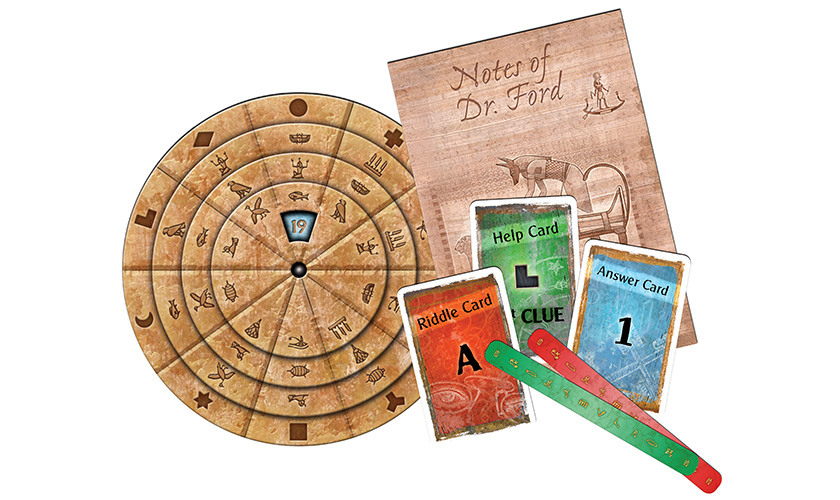I remember my excitement when the first escape room in a box was announced. Since then, announcements have been becoming more and more frequent and the pure existence of a game is no longer enough to guarantee my attention. Now, they actually have to deliver something interesting. Exit the Game burst onto the scene a few months ago with three independent games covering some of the classic escape rooms – an Egyptian game, a serial killer’s cabin game and one set in a lab. Originally they’d been released in German and, looking at the German website, we can expect to see a whole slew of games to follow (check out the Exit Games website for a full listing). With a wealth of titles on the horizon, I was excited to try out what might be a rich seam of fun!
Opening the box, you’re presented with a dizzying array of cards – about ninety in total split into Help, Answer and Riddle varieties. Riddle cards are the props and compartments of the room – you get given some at the beginning, and new ones are released as you solve puzzles and unlock new compartments and spaces. Answer cards are the padlocks – used to verify your answers and tell you which new cards to take. Help cards are the GMs of the game, providing you with two hints and an answer for each puzzle in case you get stuck. Aside from that, there’s a code wheel to help with verifying your answers, a couple of small props and a “handwritten” journal from a previous explorer which complements the Riddle cards to provide the backdrop and clues of the room.
As you’d expect, there’s a gentle introduction to the game with an easy-to-solve puzzle. In fact, it’s absolutely critical here because the mechanisms aren’t as easy as you might imagine. At first, I felt they were needlessly complicated, but I soon realised that the mechanism allows you to try a possible answer without accidentally being given clues to the correct one. It was a little confusing to start with, but we got used to it after two or three puzzles.
Unsurprisingly, the puzzles aren’t amazingly physical, and most could have come out of a puzzle book. One thing I appreciated, and I felt was a little lacklustre in the ThinkFun escape rooms in a box, was that they managed to capture the element of escape rooms where you have to find ways of connecting clues together to make a puzzle.
The booklet obviously provided the central part of the game, but the Riddle cards allowed easier sharing than might otherwise have been possible. I liked the balance – something chunky for you to get started with, that you could place in the middle of the table for sharing, but some smaller items that you could look at more closely. That also means that, when someone’s studying a page of the booklet, you won’t feel you have to wait for them to finish till you can do some more investigation.
It’ll probably be obvious from all this that that the puzzles aren’t amazingly physical. One thing I noticed in this (and in another of their games that I played subsequently) was that they do make an effort to include at least one physical aspect in the experience. It’s an impressive achievement considering that all you’ve got is a box with some cards, a booklet and two small props. It’s small innovations like that which take what would otherwise be a set of paper puzzles and transport them into a proper escape room in a box.
The game flowed reasonably well for us, although something that happened afterwards made me realise that other people’s experiences might be different. I replayed the game with my children and I found it interesting that they ended up taking a different path through the puzzles. That may sound inconsequential, but it actually had a significant impact on one of the puzzles in the game. It’s the sort of thing that would frustrate me in a real room – you think you’ve got enough information to solve a puzzle but you haven’t, and so all your effort is in vain.
The focus of the game is very much on the puzzles, and you’ll find little in the way of storyline. Having played ThinkFun’s games, I found comparing the two interesting. The puzzles here are harder, and even working out which pieces of puzzles go together can be tricky, but the narrative is lacking. I’d love to see some of the riddle cards add a little more to the storyline and help make the game that touch more immersive.
Overall, this is one of the strongest escape rooms in a box that I’ve played. It isn’t, and was never going to be, a match for a real escape room, but it’s a well constructed hour of fun with quality elements and good puzzles. If you’re an escape room enthusiast looking for something that’s more puzzle-centric, then it’s a great way of bridging that gap between escape rooms.
Full disclosure: We were given a free copy of this game for review purposes. That doesn’t influence the review – you can read more on the About page.

Permalink //
I really liked the standard of puzzles in the Exit series. I hope you’ll be reviewing their other ones, and also the Unlock games too?